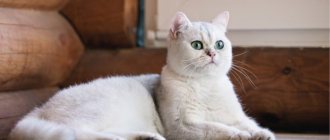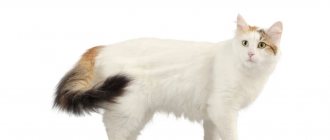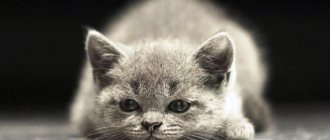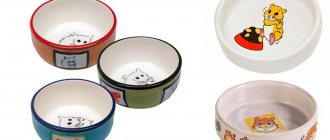Which cat is better to have in an apartment: selection criteria
When choosing a cat for an apartment, you need to understand the following features of each breed that is interesting to the buyer:
- how quickly the animal gets used to new things;
- noise (the cat should not disturb the neighbors);
- the ability to tolerate loneliness (after all, most owners spend a lot of time at work);
- contact (this is especially important if there are small children or other animals in the house);
- degree of activity (a cat that needs high physical activity will not be comfortable in a closed room);
- fussiness in care (long-haired pets will leave a lot of hair on soft surfaces if they are not combed regularly).
Important! You should choose an animal based on your own character and needs. A passive breed will not suit an active person, nor vice versa.
What to look for when choosing cats
Before getting a pet, you need to determine how much attention you can give it. If you work late and can't spend much time at home, choose an animal that can easily tolerate loneliness. When choosing a breed, take into account how active its representatives are.
Decide whether you need a pet to participate in exhibitions, for breeding, or just for fun. In the first two cases, study the kitten’s pedigree with particular passion.
If you take an animal from a nursery, pay attention to the conditions of detention, its state of health, ears and claws. The baby should not have discharge from the eyes and nose, he should be willing to make contact and be active.
Top 10 most popular cat breeds in Russia
The ranking of the most famous cat breeds includes:
- Burmese cats. Burmas are great for those who are willing to pay a lot of attention to them. They are quite contact and gentle, and also do not require much space.
- Ragdoll. Families with younger children can safely get a Ragdoll. Representatives of the breed are sweet, obedient and affectionate with people. A distinctive feature of the Ragdoll is its rare patience.
- British shorthair cat. The British are lazy and measured, which corresponds to the popular opinion about all English people. They are patient and obedient, so you can safely leave a small child with them. With proper care, Britons can live for 2 decades.
- Manx. Not everyone can choose such a luxury as a Manx. Unlike other family cats, they are by no means calm. On the contrary, Manx cats require a lot of play, exercise and communication. They are very smart: some owners even teach them commands, which brings these animals closer to dogs.
- Abyssinian cat. Abyssinians have an expressive appearance and a wonderful disposition. They are gentle, intelligent and lively, making them suitable for active families with young children.
- Burmese shorthair cat. The Burmese is a good choice for those who love cute and active pets. The fact is that this breed is classified as “eternal kittens.” Burmese retain their childlike character until the end of their lives, so there is no more suitable pet for families with children or single people who are willing to pay a lot of attention to their pets. However, it is worth considering that the weight of these beauties can reach 6 kilograms. This is where their nickname comes from - “brick wrapped in silk.”
- American shorthair cats. Americans are the generalists of the cat world. They are affectionate, playful, have excellent health, appreciate the attention of the owner and get along well with other pets. And their short hair makes them easy to care for.
- Siamese cats. The Siamese are famous among the Russian people for their aggressiveness and quarrelsomeness. However, this is just a stereotype. Siamese cats are very smart and affectionate. They love to play and appreciate the attention of their owners. There is an opinion that boys of this breed are more loyal than girls. This must be taken into account when choosing who to get - a cat or a female cat.
- Persian cats. Persians remain one of the most popular cat breeds. There are reasons for this: they are attached to the family and prefer a measured lifestyle. However, they will not refuse to play if their beloved owner offers them.
- Maine Coon. The Maine Coon is one of the most sought after cats in the world. Her proud appearance and large dimensions cannot but attract the eye. Maine Coons are quite affectionate with their owners and get along well with other pets. But with strangers they maintain cool neutrality. Despite their considerable size, they do not need a lot of free space. Maine Coons get along better with adults, and therefore are not very suitable for families with small children.
This is interesting! According to genetic tests, Maine Coons are closely related to Norwegian Forest cats.
Burmese cat
Ragdoll cat
Manx cat
Abyssinian cat
Burmese cat
American shorthair cat
Siamese cat
Persian cat
Maine Coon cat
Choosing joy for your home
Our rating is based on reviews from owners and “contrast indicators,” because cats are very different.
Best breed – favorite breed (mongrel cat)
If you are not a breeder and you do not have any special requirements, the ideal option is a four-legged dog rescued from the street or a shelter. With mongrel animals, you can't count on a certain character or skill, but you can be sure that the pet will remember your kindness for the rest of its life. Let’s not lie, among outbred cats there are quite a lot of “harmful” cats with difficult characters, but only they can boast a number of advantages:
- Most “nobles” are unpretentious in feeding and are not prone to food allergies.
- Developed intelligence - in the absence of a sharp mind and innate cunning, a cat cannot survive on the street.
- Hunting skills - most purebred cats do not hunt, but outbred cats with tails successfully exterminate pests.
- Good health and good gene pool, ensured by natural selection.
Outbred animals (those without a pedigree) cannot be bred, therefore, in the interests of maintaining health, it is recommended that animals be spayed and neutered at a young age.
Canadian finx
Probably one of the most desirable breeds for an apartment. The reason for its popularity is obvious; Sphinxes have no fur. The breed was developed by selecting representatives with genetic mutations. The fact is that even outbred cats rarely give birth to hairless or “velor” kittens.
The appearance of the Sphinx created a sensation among cat lovers. It must be said that the Sphinxes had many fans, but there were also people who did not understand the beauty of hairless cats. Most people who don't like Sphynxes change their minds when they stroke the cat's soft, velor, unusually hot back.
This is interesting! The appearance of Sphinxes is often compared to that of an alien; there is even an alien version of the origin of the breed.
Hairless cats do not have a completely feline character. Most of them are incapable of aggression, become very attached to their owner and behave a little like a dog . Sphynx dogs can be taught tricks, tolerate walks in a harness well, and quickly establish contact with other animals. The breed is not talkative, which is important for apartment living.
Hairless cats are odorless and relatively easy to keep. Compared to other breeds, Sphinxes are calmer during the heat period, cats do not scream too loudly, and cats hardly mark. With balanced feeding and a comfortable stay, representatives of the breed rarely get sick or cause inconvenience.
Note! In addition to the Canadian Sphynx, hairless breeds include the very rare Bambino, Ukrainian Levkoy, Don and St. Petersburg Sphynxes.
British cat
One of the most common breeds, bred in England through interbreed matings between aboriginal representatives of cats and Persian cats, already known at that time. The goal of developing a new breed was to obtain an apartment version of a cat that was easy to care for and without obvious health problems.
Adult British cats are large and heavy, but at the same time the muscular cat is harmoniously built. The British are loved for their round, bright eyes and cute cheeks. By the way, the cheeks of cats are much more developed. British cats are famous for their printed coat of a noble, blue color. The breed standard specifies only one color, but recently breeders have begun active work to expand the color palette and recognize the expanded standard.
Cats are considered moderately active, active with a balanced character . The experience of the owners proves that the British tend to become very attached to their owners. In relation to children, representatives of the breed are very affectionate and patient. Representatives of the breed boast a strong nervous system and resistance to stress.
Representatives of the breed do not require complex care, minus the demanding nutrition. Many Britons are prone to food allergies, which can lead to skin problems.
Scottish cat (fold and straight)
From the moment of their breeding until recently, Scottish cats were considered a separate breed. A certain external similarity with British cats led to the fact that dishonest breeders often crossed animals of different breeds. Today, as a result of this chaotic activity, the question of uniting the breeds into one – the British one – has been raised head on.
Straight-eared (straight) Scottish cats are very similar to British cats, fold-eared (fold) cats have only one difference - curved ear cartilages. The highlight of the breed is the result of a genetic mutation. According to breeding rules, mating of two Scottish Folds is strictly prohibited, but since such manipulation allows you to increase the number of fold kittens in a litter, dishonest breeders often resort to it.
Most cats born from fold litter are disabled from birth , although an inexperienced cat owner may not notice the abnormalities. If you decide to buy a Scottish Fold kitten, opt for babies with confirmed breed value (with a pedigree), otherwise you are taking a big risk.
Purebred Scottish cats are healthy breeds. Many owners note that their pets have a very good appetite. In terms of character, Scottish cats are almost no different from British cats; they are active, sociable and not too active.
Like British cats, Scots are not very picky about grooming, but need a balanced diet . With a food allergy, the cat suffers from itching, which is fraught with scratching and the formation of purulent wounds. Metis are prone to problems with bones, spine, joints, and the functioning of the hormonal system, in particular, they are prone to diabetes.
Maine Coon
A breed that is not suitable for a small apartment, since in adulthood cats weigh about 10 kilograms, cats are slightly smaller, usually up to 8 kilograms. The history of the breed stretches from America, where the ancestors of Maine Coons were called raccoon cats.
The appearance of Maine Coons is probably their main trump card. Against the backdrop of power and nobility, representatives of the breed enchant with their bewitching grace. In adult individuals, tassels are developed on the ears, like a lynx, the tail is pubescent and looks very heavy, and cats have well-developed withers and mane. Despite their solid dimensions, representatives of the breed, by nature, remain teenagers until 4–5 years of age. Due to their late maturation, Maine Coons are bred rarely and late, which explains the price and rarity of kittens.
From the outside, the Maine Coon may seem dangerous because its claws are highly developed and, hypothetically, such a cat can cause serious injuries. In fact, purebred representatives of the breed are distinguished by true kindness, they are polite with adults, affectionate with children, and forgiving if someone behaves intrusively. During adolescence, Maine Coons easily learn tricks and become accustomed to wearing a harness. Such large cats need a lot of space and love to walk outside, but walking on their own is dangerous for them. Despite their external power, Maine Coon fighters are mediocre.
This is interesting! Maine Coons do not cause trouble by meowing, but they do purr constantly.
Your pet will need several beds located in convenient places, since Maine Coons tend to sleep wherever they can (even if it’s uncomfortable). During the period of active growth and throughout life, representatives of the breed need an enhanced but balanced diet. The four-legged cat needs to be given enough time, and in childhood, the cat needs to be taught to play independently.
Exotic Shorthair (exotic)
A cat breed beloved by many, with a very interesting appearance. Such original quadrupeds were bred by crossing Persian cats and native quadrupeds from America. Thanks to the stronger genes of American aboriginal cats, Exotics have short hair, which is undoubtedly convenient for apartment living.
Note! Externally, the shorthaired exotic differs from the extreme Persian only in its long hair.
Exotic shorthair cats are very intelligent, sociable, gentle and responsive. Unlike the Persian, exotics are more active, curious and playful. Another undoubted advantage is high stress resistance. Exotic shorthair cats quickly become accustomed to people, even as adults. In terms of caring for exotics, there are no special problems if the cat is healthy. Representatives of the breed need a balanced diet and are prone to respiratory ailments and ophthalmological problems.
Persian cat
One of the most famous breeds in the world. The four-legged animals were bred in Asia and attracted the world's attention for their luxurious fur and very docile nature. Persian, without exaggeration, is the ideal cat breed for an apartment if you are ready to provide your pet with decent care and nutrition.
Representatives of the breed are well built, muscular, harmonious and very graceful. The coat is long, luxurious, elongated at the withers and tail. A small, slightly depressed nose and huge, expressive eyes give the cat a special charm. In terms of colors, the breed standard is almost unlimited, but the contrasting tabby, Himalayan and color point are considered the rarest.
Persian cats are the calmest and most domestic cats in the truest sense of the word . The breed was originally bred as a pet, pampered, not lacking care, attention and love. The four-legged animals are distinguished by their affectionate nature and absolute trust in their owner. Representatives of the breed quickly become attached to the family, sincerely love people, and treat all members very kindly.
The intelligence of the Persians is also amazing; they are able to analyze the situation for a long time and make their own, most often, correct decisions. A big plus of the breed is its complete adaptability to living in an apartment . Most Persian cats will not agree to walk outside, even if their freedom is unlimited. If you enjoy walking cats, your kitten should be harness-trained and outdoor-trained from early childhood (immediately after receiving its vaccination).
If you don't like brushing cats, the Persian is not for you. Many people find the process of caring for their pet's coat calming, which is why representatives of the breed are so popular. Your pet's coat needs to be brushed thoroughly every day! If a cat does not receive proper care, it becomes covered in tangles, and this is not only unsightly, it is painful. Persian cats shed a lot of hair when they shed, even if you groom them every day. Some representatives of the breed snore in their sleep and are prone to breathing problems, this is explained by the structure of the skull.
Important! It is better to buy a Persian cat kitten only from trusted breeders recommended by your friends.
Cornish Rex
The first impression is not deceiving, the Cornish Rex is an oriental cat, one might say, one of the interpretations of the orientals. The birthplace of the breed is in England, which is not surprising; the breeders of this country have always strived for a kind of perfection in the cat's appearance.
The Cornish Rex stands out among its relatives with its short, very pleasant to the touch, plush and wavy hair. Representatives of the breed also have wavy mustaches. The quadrupeds are built very harmoniously, despite their high legs and developed muscles. When on the move, the Cornish Rex is graceful and very confident. Distinctive features include an elongated head shape and very impressive ears. Due to the short hair, the Cornish Rex's tail looks very thin, and due to the pet's sociability, it constantly wriggles and bends in a funny way.
Note! Cornish Rex dogs do not shed, do not sweat, do not smell, and when properly cared for, do not leave traces of sebum.
If you live in a one-room apartment and for this reason alone cannot get a dog, choose a Cornish Rex. This cat has truly a dog's devotion and somewhat of a character. The Cornish Rex quickly becomes attached to its owner and endures a change of owner extremely painfully . Representatives of the breed get along with dogs and other animals without any problems. In relation to children, Cornish Rexes are patient and affectionate; towards strangers, they are a little distrustful.
The Cornish Rex is a very intelligent, intellectually demanding breed. Four-legged dogs learn commands well, walk happily on a leash, and have fun with interactive toys. Against the backdrop of mobility and curiosity, Cornish Rexes are unobtrusive and if the pet sees that the owner is not in the mood or time to play, he simply observes everyday life.
Probably the biggest plus of the breed is its unpretentiousness . With the right choice of diet, cats eat well, are not picky, and tolerate regularity in their diet. There is only one caveat - the pet must have conditions for leisure, otherwise it will eat out of boredom and gain weight.
Ragdoll
Oddly enough, such calm cats are descendants of Siamese, which have a very lively disposition. However, when bred, the character of the Siamese was no secret. Therefore, many specially selected, most flexible Persian cats took part in breeding work. Some experts still do not recognize that Siamese cats and Ragdolls are relatives and believe that the latter's docile nature is the result of a gene mutation.
The calmness, complaisance and obedience of the representatives of the breed are so unshakable that groups of breeders struggled to overcome this feature. the fact is that when Ragdolls appeared in Europe, a myth was born about the fearlessness of these four-legged animals and their inability to feel pain. Behavioral studies have shown that the phlegmatism of the breed's representatives in some way conflicts with the survival instinct - the strongest instinct of any creature.
Note! According to the breed standard, the Ragdoll is far from phlegmatic, but affectionate, flexible, demanding of communication, calm and intelligent.
Munchkin
A phenomenal breed of short-legged cats that have been compared to basset hounds, dachshunds and even kangaroos. The last comparison is due to the fact that Munchkin tends to rise on his hind legs and stand in a column for quite a long time. Munchkins are very attentive, curious and often amaze their owners with their level of intelligence.
Note! Quadrupeds differ in the length of their fur, but it is always velvety and very soft to the touch.
By nature, representatives of the breed are very affectionate, responsive and flexible. Munchkins are very attached to their owners , sometimes even too much. For example, Munchkin owners say that until the pet grew up, he followed him everywhere, even to the bathroom and toilet, and if you closed the door in front of his nose, the ward began to worry and seriously panic. For some owners, it is very important that the cat does not climb everywhere, and Munchkin fully meets this requirement; due to his physique, he simply cannot jump high. By the way, on their claws, on a porous surface, these cats can rise quite high.
The Munchkin is not quite adapted to being alone for a long time , but representatives of the breed tolerate travel and a change of environment very well. Four-legged animals love to walk on a leash and the attention of strangers, believe me, many will not be able to pass by such a pet without emotions. With appropriate upbringing, you can raise a Munchkin to be a full-fledged companion, and although the pet will not be able to bring you slippers, comfort you in grief or make you laugh on a gray day, it is quite capable.
The easiest cats to care for in an apartment
When choosing a cat for your home, you should take into account that this or that breed requires different attention. Long-haired beauties are not the best choice for busy owners because they leave a lot of hair on carpets and furniture.
On the other hand, a completely bald Sphynx is also not the easiest option. This breed has a special regulation of body temperature: they are cold in winter and sweat in summer. Therefore, it is quite difficult to provide them with a comfortable existence.
Sphynx cat
The list below includes short-haired cats that do not require lengthy brushing:
- Abyssinian (rarely sheds);
- Bombay (healthy and unassuming breed);
- Egyptian Mau (one of the oldest breeds, it is healthy and does not require special care);
- Cornish Rex (rarely sheds, the coat feels like velor);
- Siamese (combing once a week is enough);
- oriental (practically does not shed).
Bombay cat
Egyptian Mau cat
Cornish Rex cat
Oriental cat
Important! Brushing the coat is not the only grooming requirement. Cleaning the eyes and ears, checking the condition of the teeth and claws - these are the things that are relevant for any cat.
Cat or cat - who is better?
You need to decide on the gender first, since the behavior of females and males is different, and their care is somewhat different. It is generally accepted that cats are more disciplined, affectionate, calm, compliant, and physically active. Cats are lazy, proud, silent, selfish, sedentary. You should not rely on general stereotypes, since each animal is individual, but some factors need to be taken into account.
- Cats are larger and have a stronger smell. With proper care, no unpleasant odor is felt, so there is not much difference.
- Cats try to take a dominant position, so you need to immediately show who is boss in the house and who you have to listen to. Cats are manipulators. They obtain the fulfillment of desires without open confrontation with household members.
- Before puberty, there are no differences in behavior between kittens. During heat, the cat expresses its needs too loudly, meows all day and night, cats intensively mark their territory, become aggressive, and are able to run away from the house.
- Cats are more active, cats are difficult to stir up. If an animal is bred to fight mice, a cat is better suited.
Considering the fact that cats are brought in as living toys and are sterilized, there is not much difference in care, and problems, in general, do not arise. Therefore, the choice depends solely on the preferences of the owner.
The calmest cat breeds
The best cat breeds for apartments based on the criterion of balanced character include:
- Scottish Fold: quickly becomes attached to owners, but does not really like strangers;
- British Shorthair: easily gets used to a new home and is ready to contact the family;
- Persian: this breed of cat is suitable for those who like to communicate frequently with their pet. For Persians, the attention of their owners is very important, and they rarely show their dissatisfaction;
- Burmese: affectionate and playful cats, get along well with people of different age categories;
- Russian Blue: the pride of Russian selection. An extremely friendly breed, which nevertheless is able to easily tolerate the long absence of the owner from the house. One of the most common cats in the world;
- ragdoll: a beautiful purebred cat, has a very kind and gentle disposition;
- exotic: a fashionable breed that harmoniously combines loyalty and unobtrusiveness;
- Canadian Sphynx: non-aggressive, quickly becomes attached to the owner, easily finds a common language with other animals. He can be taught tricks and walked in a harness.
Scottish fold cat
Russian blue cat
Exotic cat
Canadian Sphynx
This is interesting! Sphynxes rarely meow, which is important for a city apartment with thin walls.
How to choose the right kitten and why should you choose cubs?
Before getting a pet, of course, it is worth deciding how much living space it will subsequently receive, and how much attention and effort it will require in caring for it. It is important how much the cat’s character can fit into the rhythm of the owner’s life. How much time does he spend at home?
The composition of the family, its way of life, the amount of free time and financial capabilities are of great importance when choosing a cat. In addition, it is necessary to take into account the presence of children and other pets, the tendency of cats to aggression and jealousy.
The conditions of a city apartment are actually different for each family. However, they come down to limited free space, high density of interior items and often the combination of many functional areas. Having a kitten means shifting your priorities somewhat: instead of the usual order and tranquility in the house, you need to be prepared for the fact that his appearance will disrupt the order of things. Both literally and figuratively.
Therefore, for keeping in a limited space, you need to choose calm phlegmatic people, melancholic people, and in extreme cases, sanguine people, and not choleric people. Yes, yes, cats also have their own temperament, and a highly active cat of the Siamese-Oriental group, even if you get him as a very small kitten, will be able to turn the whole apartment upside down in one sitting.
Traditional domestic breeds are considered the best idea for apartment keeping.
The British Shorthair or Persian cat will delight you with its even and balanced character, and it is difficult to imagine it riding on a ledge. The characteristics of these breeds imply a calm and stable psyche of cats.
This also includes all Scots by origin: Scottish and Highland also have an undoubted advantage in easy adaptation and adaptability to an apartment.
Of the exotic breeds, all types of Sphinxes are considered the most “apartmental”. They will fit perfectly into the decor of an apartment, however, they need a person a little more than people from Foggy Albion or Persians.
• Pet's age.
Some people prefer "mutts". These cats did not have noble ancestors in their family or they have mixed roots. And this has its advantages. For example, mestizos have better health than their “blue-blooded” counterparts. This is due to the wider gene pool. Therefore, the risk of genetic diseases is very low.
However, such cats often have an independent character, and their hunting instincts are more pronounced. Adults love to mark territory, and it is not very easy to wean them from this habit.
The “mongrel” has better health
At the same time, purebred cats have predictable habits. They value cleanliness more because breeders select for breeding those individuals that are less prone to marking territory.
An adult cat or a cute baby? This seems like a minor issue, but age is an important factor.
Kitty
As a rule, kittens are taken into the house. It is believed that in childhood the animal gets used to the new environment better.
A cat feeds its cubs with milk until they are three months old. This is important because the baby acquires primary immunity. It is the mother who takes best care of health and knows what her “child” needs. Communication with the parent is also responsible for socialization. An early break with a nursing female is fraught with the following problems for the offspring:
- mental disorders;
- behavioral disorders;
- weak immunity.
The mother accustoms the cubs to unfamiliar food, instills hygiene skills, shows how to use a tray and sharpen their claws.
Temporary immunity is transmitted to the kitten with milk.
Cats are vaccinated at 8 and 12 weeks (booster vaccination). Therefore, after 3 months the body is maximally protected from infections.
Adult cat
Animals older than a year are reluctant to be taken into an apartment due to prejudice. But veterinarians assure: often these are just myths that have no basis in reality.
Table 1. The most common misconceptions of future cat owners.
| Myth | Reality |
| It is easier to train a kitten to the litter box | Adults quickly understand what is wanted from them. And if they are already toilet trained, they will not shit anywhere, with rare exceptions and for “good reasons” (stress, illness, etc.) |
| An adult cat will not accept a new owner | Animals that have experienced cold and hunger appreciate taking care of themselves. Kittens take everything for granted and are spoiled |
| The child needs a kitten | Adult cats are more tolerant of children. Many of them have the talent of a nanny and stoically endure the importunity of children. |
| The owners abandoned the cat because he behaved badly | An animal may be left without owners due to their death, relocation, birth of a child, or other “harmless” reasons. |
| If you take a kitten, it will grow up healthy | This is not a fact due to unformed immunity. Kittens are more prone to serious illnesses and suffer more severely from infections. |
Adult cats are often more comfortable than kittens
People who decided to take such a step believe that it was done correctly. They argue that there are many reasons why a shelter cat will do well in an apartment.
Table 2. Pros and cons of a shelter cat.
| Advantages | Flaws |
|
|
As for communication with curators, this is a temporary phenomenon. As soon as volunteers or shelter workers understand that their pupil is in good hands, they stop disturbing the new owner.
Don't be afraid to adopt a cat from a shelter - this has its advantages
Shelters are also found through social networks - usually such organizations have pages. If you couldn’t find an adoption center in your city, you will definitely find one in a neighboring town.
Those who want to get a cat need to know what difficulties they will have to face, regardless of the breed and gender of the animal. A person who is used to traveling should realize that a cat is a homebody who does not like traveling. Rare pets agree to share the road with their owner and even go to the mountains with them.
You need to be patient in order to instill basic skills in your cat - teach him to go to the litter box and sharpen his claws not on furniture, but on a scratching post. Training requires perseverance from a person; training takes energy and time. If there is no desire to work with your pet in this direction, then soon the house will be a mess.
The cat needs to be taught basic skills - to learn to use the litter box.
Playful cats for the apartment
The most active and irrepressible breeds include:
- Abyssinian cat: always explores the whole house and climbs the hills, while managing to follow the movements of the owner. If it seems to her that the owner is busy with something more interesting, she will definitely rush to “help” him;
- Bengal cat: a miniature leopard that matches the habits of its wild ancestors. Bengals love to play and explore new things;
- Egyptian Mau: has many similarities with the Abyssinian cat, which is not surprising, since both active beauties were favorites of the pharaohs;
- Turkish Van: playfulness is about him. The cat loves to explore, climb and swim. Van really enjoys interacting with his owner and is devoted to only one owner all his life;
- Ocicat: a breed that adapts well to human habitation. Cats are great at opening cabinets, bedside tables and doors, and then enthusiastically explore the new space;
- Kurilian Bobtail: an aboriginal cat, has many canine traits in its character (very smart, devoted to its family, easily learns commands and is somewhat suspicious of strangers).
Bengal cat
Turkish van cat
Ocicat cat
Kurilian bobtail cat
This is interesting! Bobtails are one of the few cats that do not mark their territory. In addition, they love to swim, and therefore, in addition to hunting, they love fishing.
Javanese
Unlike the two previous breeds, the Javanese is not so strongly attached to its owner in terms of the latter's absence. No, he will sit on your knees, purr, ask for affection and keep you company in bed, but if you are gone for a long time, the pet will not experience severe mental anguish.
The cat feels equally good both with children and in a large company of guests. She does not hide in the corners, but tries to communicate with everyone, looking for those who will support her games. The breed loves walks in the fresh air and is passive towards dogs barking at it.
Javanese is good for everyone, but needs a balanced diet and regular visits to the veterinarian, because it is susceptible to various diseases. If you get vaccinations on time and feed your cat good food, then there will be no problems.
Cat breeds for children
Choosing a breed that is suitable for a child is not so easy. On the one hand, the animal must be loyal to games, and on the other hand, be patient and forgive children's pranks.
Cats that equally possess these qualities include:
- Kurilian bobtail (a playful “catdog” who will gladly share the child’s enthusiasm);
- Manx (a very smart and energetic cat, he prefers intellectual games);
- Turkish Van (suitable for an older child who can look after him and become a full-fledged owner for the pet);
- ragdoll (a calmer cat for children that can easily tolerate careless pranks);
- Burmese cat (contact and affectionate Burmese cats will be happy to receive the attention of their little owners).
To overpay or not to overpay for the breed and its documents?
Kittens with a pedigree are many times more expensive than regular kittens. If you are not going to start breeding a breed or participate in exhibitions, then it is not necessary to overpay for a pedigree. You can purchase a pet with slight deviations from the standard. It will cost much less.
Buying a kitten from a nursery guarantees its health, since the breeder must provide a veterinary passport for the animal. It indicates vaccinations and previous diseases.
If you adopt a kitten from a shelter, then this is also a guarantee of its good health. If the animal is sick, the shelter workers will warn you about this and recommend a clinic.
The riskiest thing is to buy a kitten at the poultry market or through an advertisement. There is a high risk of getting a sick pet, and no one will warn you about this. Also, mestizos or barn cats are often sold under the guise of purebred animals.
Pros and cons of breeds
| Breed | Attitude towards people | Attitude towards animals | Easy to care for | Energy | Passivity |
| Burmese | + | + | — | — | + |
| Ragdoll | + | + | — | — | + |
| British Shorthair | + | + | + | — | + |
| Manx | + | + | + | + | — |
| Abyssinian | + | + | + | + | — |
| Burmese shorthair | + | + | + | + | — |
| American Shorthair | + | + | + | + | — |
| Siamese | + | — | + | + | — |
| Persian | + | + | — | — | + |
| Maine Coon | + | + | — | + | — |
| Egyptian Mau | + | + | + | + | — |
| Turkish van | + | + | + | + | — |
| Kurilian Bobtail | + | + | +/- (there are representatives with different hair lengths) | + | — |
Of course, there are many cats suitable for apartment living. The future owner needs to thoroughly study several breeds that he likes. With a thoughtful and balanced decision, you can achieve the main thing - to receive love and joy from communicating with an animal that best suits a particular family.
Tips for choosing, recommendations and nuances for keeping cats with a gentle character
Those who decide to become the owner of a calm and affectionate cat should consider the following nuances :
- You should not allow a child to mock your pet, because even the quietest and most affectionate cat can run out of patience;
- affectionate and sociable cat breeds have a hard time withstanding loneliness, so you should not buy a pet for a business person who rarely appears at home;
- an affectionate pet requires attention every day, asks to be on your lap - you cannot refuse it: even if you are very busy, you should play with the cat for at least a few minutes;
- if there is a child in the family, it is better to buy a breed that is energetic, sociable, resistant to stress, and lacks aggression;
- It is strictly forbidden to physically punish a pet - despite its kindness and easy-going nature, it will remember evil, and trust will no longer be unlimited.
Potential difficulties of living with a cat
To prevent your new friend from using the carpet as a toilet, keep his litter box clean
Although four-legged friends are clean, sometimes they can go to the toilet in the wrong place. This behavior can be due to various reasons. Of course, an unpleasant smell in an apartment destroys the atmosphere of comfort, but you should treat this with patience. To avoid such incidents, we advise you to take a pet that is litter box trained. Take the time to train your tailed dog and then your pet will be neat and obedient.
Another difficulty that future owners often forget about is that animals shed. Their fur can remain everywhere: on clothes, in food, on all surfaces. To keep the apartment clean, you will have to clean more. In addition, it will be necessary to constantly comb the tailed ones. If this is a serious problem for you, consider getting a smooth-haired tabby or a Sphynx.
Animals have different temperaments. Active, lively cats with hunting instincts require a lot of space to play and prefer to walk outside. They love to run, overturn objects and sometimes damage furniture. If you live in a small apartment, take a closer look at a breed that is characterized by: moderate activity, a calm attitude towards loneliness.
Manx
This unusual tailless cat is an example of true devotion and love. These cats are very playful and intelligent, so you can often hear comparisons of this breed with dogs.
Some skillful owners manage to teach their Manx some commands. These cats are very sociable and active, so they are suitable for both active adults and children.
Persians
These walking ottomans love a measured and leisurely lifestyle. They become very attached to their owners, while strangers do not arouse any interest in them.
They are well suited for those who are not used to an active lifestyle.
They love to explore new things and can be quite active if played with.
Of course, you cannot choose a pet based only on general descriptions. Each animal has its own character, sometimes unusual for the breed. So try to find a middle ground between your mind and your heart when choosing.
Siamese
And although for many Siamese are associated with aggressiveness and a bad character, this does not prevent these animals from remaining one of the most successful cats for an apartment.
Representatives of this breed are very intelligent, playful and affectionate. It is better to give preference to males; they are believed to be more loyal and gentle than females.
Is it worth adopting a mongrel cat?
A good friend can be without a breed
A purebred cat, like an animal with a pedigree, can become a faithful family friend. A tailed dog, picked up on the street or chosen in a shelter, will remember a good deed and repay with diligent behavior. But sometimes you come across cats with complex personalities.
Often outbred cats are unpretentious in feeding and do not have allergies. Such animals are intellectually developed. They have developed hunting skills, so they are able to catch an uninvited guest.











